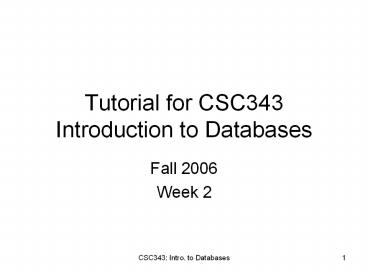Tutorial for CSC343 Introduction to Databases - PowerPoint PPT Presentation
Title:
Tutorial for CSC343 Introduction to Databases
Description:
Tutorials: Week 2, 3, 4, 5, 7, 9, 10, 11, 12, 13 (10 times). Week 6: ... Emp (eid: integer, ename: string, age: integer, salary: real) Works (eid: integer, did: ... – PowerPoint PPT presentation
Number of Views:98
Avg rating:3.0/5.0
Title: Tutorial for CSC343 Introduction to Databases
1
Tutorial for CSC343Introduction to Databases
- Fall 2006
- Week 2
2
T.A. and Tutorials
- Yuan An
- yuana_at_cs.toronto.edu
- Tutorials Week 2, 3, 4, 5, 7, 9, 10, 11, 12, 13
(10 times). - Week 6 Postgres SQL by Kiran Gollu.
- Week 8 Midterm (no tutorial).
- Some even-numbered questions.
- Answers for odd-numbered questions
- http//www.cs.wisc.edu/dbbook/openAccess/thirdEdi
tion/supporting_material.htm
3
Exercise
- E. 3.2 How many distinct tuples are in a relation
instance with cardinality 22? - Answer Since a relation is formally defined as
, if the
cardinality is 22 (i.e., there are
), there must be distinct tuples.
4
Exercise
- E. 3.4 What is the difference between a candidate
key and the primary key for a given relation?
What is a superkey? - Answer The primary key is the selected
- by the DBA from among the
- . A candidate
key - . A superkey is
- that
.
5
Exercise
- Superkeys
- Candidate keys
- Primary key
6
Exercise
- Superkeys
- Candidate keys
- Primary key
7
Exercise
- Superkeys
- Candidate keys
- Primary key
8
Exercise
- E. 3.6 What is a foreign key constraint? Why are
such constraints important? What is referential
integrity? - Answer A foreign key constraint requires that
the values on a set X of attributes of a relation
R1 must appear as values for - of
.
9
Exercise
- E. 3.6 Answer Foreign key constraints are
- important because they provide safeguards
- for insuring the of data.
- Referential integrity means all
- are enforced.
10
Exercise
11
Table Definition
- An SQL table consists of an ordered set of
attributes, and a (possibly empty) set of
constraints - Statement create table defines a relation schema,
creating an empty instance. - Syntax
- create table TableName( AttributeName Domain
DefaultValue Constraints , AttributeName
Domain DefaultValue Constraints
OtherConstraints )
12
Example of create table
- create table Employee( RegNo character(6)
primary key, FirstName character(20) not
null, Surname character(20) not null, Dept
character (15) references Department(DeptName)
on delete set null on update
cascade, Salary numeric(9) default 0, City
character(15), unique(Surname,FirstName))
13
Example
- create table Employee( RegNo
char(6), FirstName char(20) not null, Surname
char(20) not null, Dept char(15), Salary
numeric(9) default 0, City char(15), primary
key(RegNo), foreign key(Dept) references
Department(DeptName) on delete set null on
update cascade, unique(FirstName,Surname))
14
Exercise
- E. 3.8 Answer each of the following questions
briefly. The questions are based on the following
relational schema - Emp (eid integer, ename string, age integer,
salary real) - Works (eid integer, did integer, pcttime
integer) - Dept (did integer, dname string, budget real,
managerid integer)
15
Exercise
- Q1. Give an example of a foreign key constraint
that involves the Dept relation. What are the
options for enforcing this constraint when a user
attempts to delete a Dept tuple?
16
Exercise
- A1 CREATE TABLE
- (
, -
, -
, -
, -
, -
- )
17
Exercise
- When a user attempts to delete a Dept tuple,
there are four options - Also delete all tuples that refer to
it. - Disallow the of the Dept tuple if some
tuple refers to it. - For every tuple that refers to it, set
the did field to the did of some . - For every tuple that refers to it,
set the did field to .
18
Exercise
- Q2. Write the SQL statements required to create
the preceding relations, including appropriate
versions of all primary and foreign key integrity
constraints.































